The Solway coast is a place of enchantment, water-colour views and gentle hills. It is full of sites of historic importance – ancient monasteries, duns and castles – and spectacular gardens. The Solway Firth produces excellent seafood and the local dairy and beef farmers are deservedly proud of their produce.
You officially start the Solway Coast National Tourist Route at Annan. However, if you want to keep driving when you finish the Borders route, you can take the beginning of the Galloway National Tourist Route from Gretna. The road keeps as near to the coast as possible and the Solway Coast Heritage Trail is easy to follow because it’s way-marked with the symbol of a Celtic cross.
You leave Gretna on the B721, heading for Annan, with views across either water or mudflats, depending on the state of the tide. This area used to be a military ammunition storage depot and there’s a museum all about it at Eastriggs.
Heading into Annan
Annan is a handsome old market town. There’s a long-distance path starting from here, as well as a series of cycle routes, so it’s a good place to park up for a day or two and explore under your own steam. It’s also a good place to stock up on supplies of food and drink, with plenty of good shops in town.
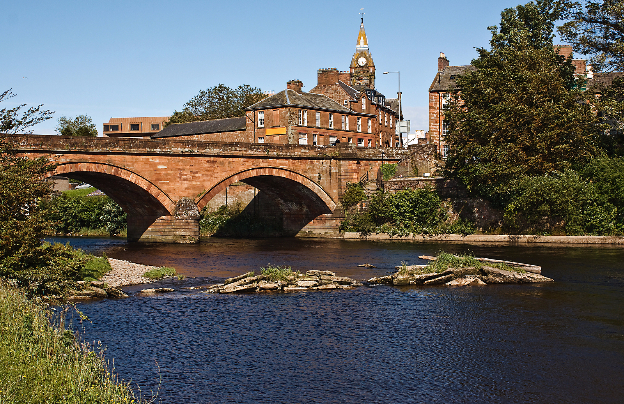
You leave Annan on the Dumfries road but almost immediately turn left onto the B724. This is not your standard tourist route: it’s flat and somewhat dull. But you soon head back to the coast, at Ruthwell. There’s an important coastal nature reserve here with rare orchids, ospreys and migrating birds. If your interests are more historical, head for Caerlaverock Castle, with its moat and uniquely (for Britain at least) triangular shape.
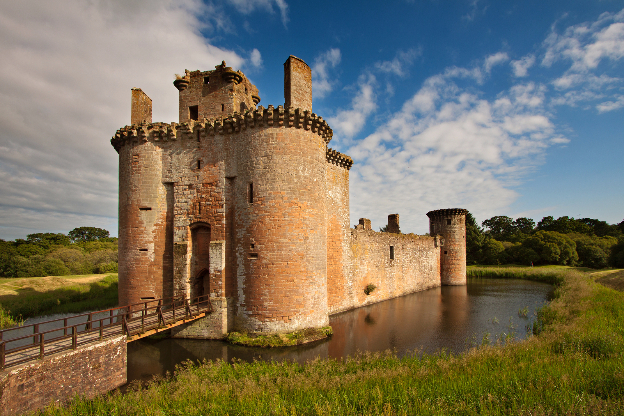
Heading north along the River Nith
From Caerlaverock you follow the River Nith north towards Glencaple and Dumfries, where you touch base with the Galloway Tourist Route again. Dumfries is the largest town in this part of Scotland. It has all the usual shops and some interesting buildings in the town centre and a pretty riverside park, so it makes a good stopping-place.
Sweetheart Abbey at New Abbey
After Dumfries the Solway Coast route separates again from the Galloway one, and you head south along the A710. At New Abbey you’ll find the ruins of Sweetheart Abbey, founded by Lady Devorgilla. She was the wife of John Balliol, King of Scots 1292-1296 (his father founded Balliol College, Oxford).
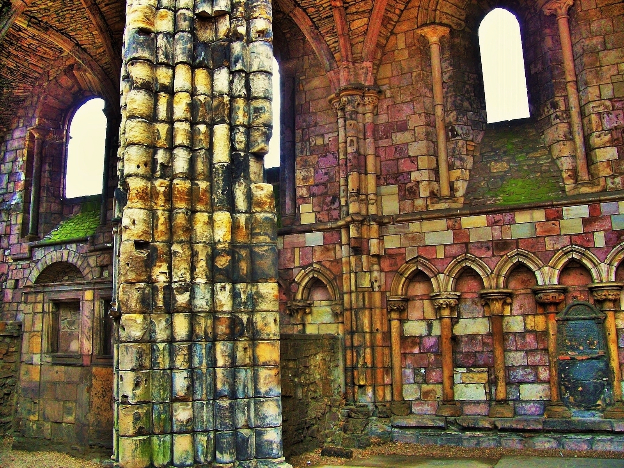
The name of the Abbey has two possible origins. The official one is that the monks named it after Lady Devorgilla’s devotion to her husband; the other is that it’s where she buried his heart (the rest of him is interred in France). Maybe both are true – it’s worth a visit to find out!
Settle in at Southerness Holiday Park by the Beach
After New Abbey you’ll find Southerness Holiday Park, which has hard-standing pitches for tourers and sits right on the beach so you can watch the sun set over the Solway Firth. Its facilities include an indoor pool, in case your idea of holiday bliss doesn’t include sea-and-mud bathing.
The road potters on towards Dalbeattie. If you take the side-road to Rockcliffe and park in the village, you can walk up to the Mote of Mark, a hill-fort dating from the 5th century, where items have been found that were traded from all over Europe. It makes for a good short leg-stretch.
Meeting up with the Galloway Tourist Route Once More
At Dalbeattie you cross the Urr Water, meeting up with the Galloway Tourist Route for the final time, and then head south again, taking the scenic route to Kirkcudbright (pronounced Kircoobry, naturally). The town’s name comes from “Kirk of St Cuthbert” and it was an early centre of monasticism.
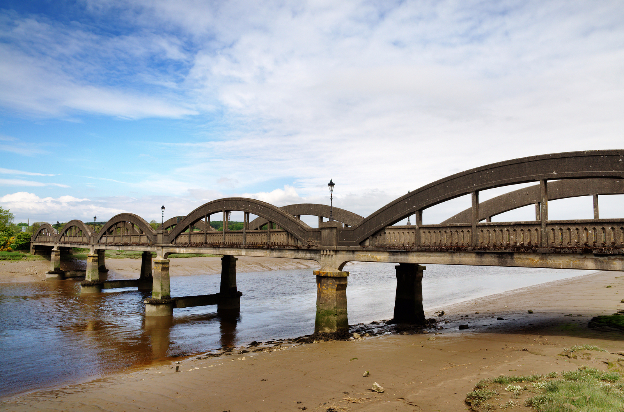
It’s a picturesque place, with pastel-coloured houses, a ruined castle and a harbour all vying for attention. It was a wealthy cloth-trading town well into recent history, and there’s plenty to catch the eye as you wander round town.
From Kirkcudbright you head for Gatehouse of Fleet. There are several routes you could follow (the official one is the A75) but none of them take you very close to the coast: most of the roads to the sea are dead-ends.
Gatehouse is another pretty painted town that’s worth a wander. When you leave it, you’ll get plenty of coastline to follow: the route clings to Wigtown Bay like a lover. The road now misses Creetown, preferring the marshes, but it’s another pretty town if you fancy bypassing the bypass.
Heading into Newton Stewart
Next stop is Newton Stewart, an intriguing old town straddling the River Cree, which is popular with anglers. The town is comparatively recent, dating from the 17th century: it was the New Town of Stewart, and was obviously prosperous as it held two markets a week.
If you’re a book-lover, schedule some time in your next port of call, Wigtown. It bills itself as Scotland’s Book Town, and there are bookshops all over the place (mostly for second-hand books). It can be a very expensive stop-over…!
The route changes number a short distance further on, from the A714 to the A746. It takes you to Whithorn, site of an ancient Priory, which lies hidden up a side street of the town. You can also make the short detour to the Isle of Whithorn, which stopped being an island when people started building houses along the causeway from the mainland. Originally it was a place of peace for medieval monks, now it’s a thriving harbour village.
Port William
Port William, not to be confused with Fort Wiliam, is your next stop. Shortly before you reach it, on the hill above Barshalloch Point, sits the 2,000 year-old ruins of Barshalloch Fort, a defensive farmstead. From up here you can see all the way to the Isle of Man (source of many pirate raids in days gone by), the Mull of Galloway and even Northern Ireland on a clear day.
After Port William you follow the coast most of the way to Glenluce. There’s a ruined abbey just outside the town there; the local tower house, the Castle of Park, is owned by the Landmark Trust and isn’t open to view.
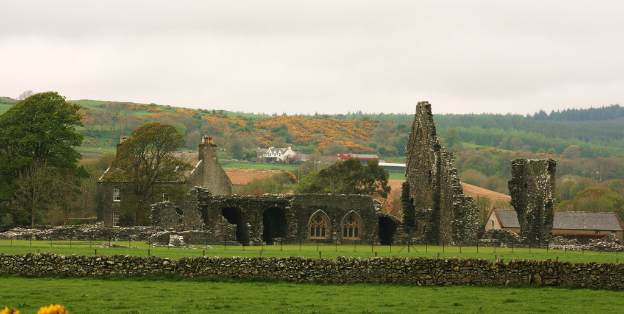
Sands of Luce, one of Scotland’s Top Beaches
The vast expanse of the Sands of Luce, just south of the town, regularly make the list of Scotland’s top beaches. You reach them from the appropriately-named village of Sandhead. There’s an award-winning touring caravan park on the Sands that takes motorhomes and has (so they say) the best views in Galloway.
The sands follow the coast all the way down the Rhins of Galloway, as does your route. Galloway’s unique climate means that there are six major gardens, open to the public, in this corner of Scotland. Three are on the Rhins, one’s at Portpatrick and the other two are between Stranraer and Newton Stewart. So if you’re a garden fan, this is a great place to visit.
Scotland’s Most Southerly Point, the Mull of Galloway
The last few miles to Scotland’s most southerly point, the Mull of Galloway, are on unclassified roads. There’s an RSPB centre, and a lighthouse which houses the Mull of Galloway Experience (you can climb all the way to the top, if you want).
Your route home goes via Port Logan, Portpatrick (which has a stunning harbour as well as the garden) and Stranraer, which used to be the port for ferries to Northern Ireland. This is where the Solway Coast Heritage Trail ends, on Loch Ryan. From here you can head on up the coast to Ayrshire, or head inland via Newton Stewart to Edinburgh, depending how much time you have.
If you want to discover Scotland’s south-west corner for yourself, please get in touch to plan your motorhome escape.